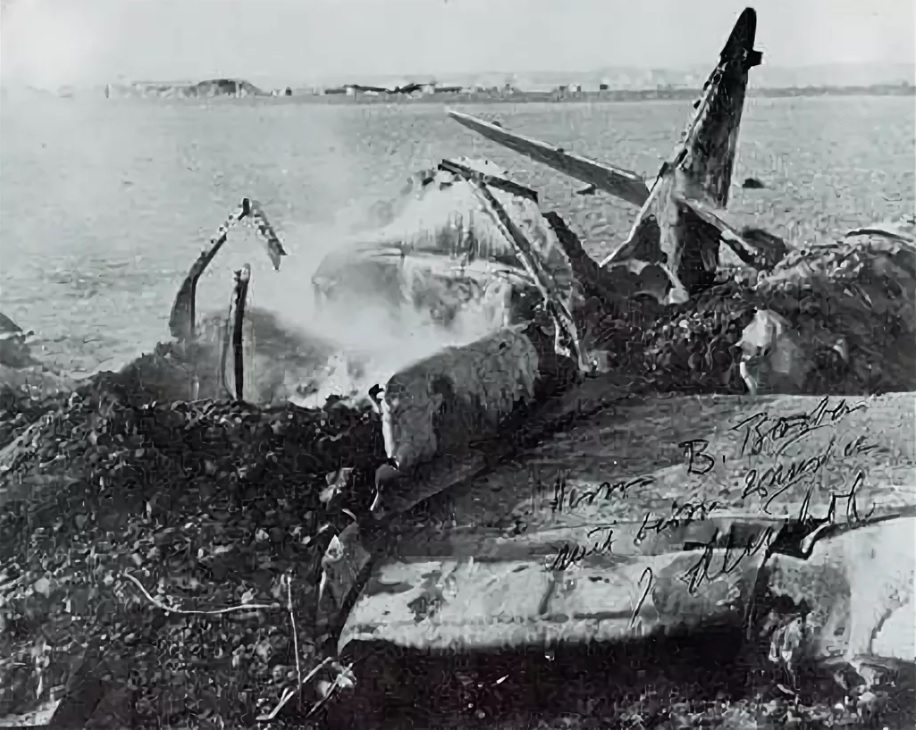As odd as it may seem, I had been unaware of these terrors until I watched somebody play the WWII video game Secret Weapons Over Normandy, where they appear as an unexpected enemy. I nearly cringed at the sight of the Axis powers having one glaring technologic superiority over us (we can grant them that), but it is apparent that even these monstrosities could not turn the tide of the war. What happened?
A brief history, first. Jet fighters had been a theoretic possibility since at least the 1920s, and the Fascists commenced experimenting with jet propulsion in the late 1930s. The experiments with jet fighters in particular became successful in the summer of 1942, and the Me 262 was officially ready for deployment in April 1944. The Eastern Axis even constructed one prototype in 1945 largely based on it: the Nakajima Kikka. So far so good, but while the Third Reich had over one thousand two hundred of these jets in storage (making them WWII’s commonest jet by far), only several dozen of them were actually ready to fight at any given time, and perhaps only four hundred in total ever saw any action.
This was not all. Although it is hardly deniable that the Me 262 was a remarkable work of engineering, it had its weaknesses and limitations as well. Because the jets sucked up so much fuel, they could only stay in the air for approximately one hour, whereas an ordinary Allied warplane could stay in the air several times longer than that. Like some of the Axis’s other innovations, the Me 262 proved to be somewhat gimmicky.
The jet’s strengths and weaknesses were almost like those of a cheetah. The cheetah is famous for being the world’s fastest animal, but what is less known about cheetahs is that they can only sprint so far before becoming exhausted. Gazelles, in contrast, are slower, but they can sustain their modest speed for a longer period of time (which is why cheetahs have yet to extinguish them).
Berlin’s order to construct versions that could bomb, a function never intended for the Me 262, complicated its production, and another important problem was that the pilots found jets troublesome to fly, even after they received training for them. The pilots simply weren’t used to this new technology; transitioning from traditional warplanes to jet fighters proved awkward. Quoting Walter Schuck:
In an Me 109 plane, one could just switch off the engine and drift down slowly […] but in this plane it wasn’t possible at all. I was traveling at a speed of 500 mph and couldn’t reduce it. The plane just wouldn’t descend. I had to fly in circles until I reached an altitude where I could ask for permission to land. Once I finally landed, I was completely soaked in sweat…
Dan Snow notes another problem:
The cockpit itself was cramped, basic, and clumsy. With the [Axis] essentially relying on a decentralised network of labour camps to create parts for the aircraft, the instrument panels inside would vary from jet to jet.
Very sadly, the Axis sacrificed dozens of thousands of neoslaves for many of these jets, and they ended lives more directly by destroying hundreds of Allied vehicles. It was not only uncomfortable but very difficult for Allied pilots to face them head‐on since they had never dealt with rapid machines like these before. Even so, the Allies managed to take out around one hundred of them. How?
The trick was to intercept them while they were either taking off, landing, or stationary. In fact, this was the standard method for dealing with them; successful dogfights against them were uncommon, but since the jets were incapable of making sharp turns, it was still possible to destroy them as they were in the middle of flight, too.
Pictured: An Me 262 on an Axis airfield.
I should mention that technically the Allies did deploy some jets of their own for combat. The problem was that the Gloster Meteor was slower, less heavily armed, rarer, and saw less action than the Messerschmitt Me 262. When the Allies officially deployed it in 1944, its only purpose was to intercept Axis rockets targeting the United Kingdom, and even after London approved it for continental use, its purpose remained primarily defensive rather than offensive. It probably never got into any (conventional) dogfights with the Axis either, as the Western Allies feared the possibility of the Axis or the Eastern Allies recovering a copy. So the Gloster Meteor could not really compete with the Axis’s jets despite being the best candidate for the job.
Finally, arguably the Me 262’s greatest weakness (like its extremely rare Eastern counterpart the Nakajima Kikka) was the want of resources, including time. They officially appeared late in the war, only a few hundred ever saw any action, and the Allies’ successful seizures and destructions of Axis resources, most notably oil, made the jets too costly to manufacture and deploy in larger numbers. With all of these factors taken into account, the Me 262 was less terrifying than it could have been, and few other Axis jets even made it past the conceptual stages.
Pictured: Miniature model of the Messerschmitt P.1111, a proposed Axis jet that never saw the light of day.
Many remember the Me 262 for being history’s first successful jet fighter and for its long‐term influence on many later flightcraft, but we can derive another lesson from it: as our oppressors taught the Yugoslavs in the 1990s, and are teaching the Palestinians now, the Me 262 can serve as another reminder that technology isn’t everything.

Pictured: A ruined Me 262.
Further reading:
The race for Hitler’s X‐planes: Britain’s 1945 mission to capture secret Luftwaffe technology
Click here for events that happened today (August 22).
1895: László Almásy, Axis aviator and explorer, was born.
1938: Prinz Eugen launched at the Germaniawerft yard in Kiel.
1939: Joachim von Ribbentrop and the Reich’s delegation departed Berlin aboard two Condor aircraft for Königsberg, East Prussia. With a nonaggression pact nearly secured with Moscow, Berlin ordered the reinvasion of Poland to commence four days later. The top military commanders received orders to be brutal and show no compassion in the upcoming conflict, but the Chancellor said that even though he was important for Germany, anybody could murder him at any time. Less importantly, Georg von Küchler became the commanding officer of 3rd Army and Westerwald began supporting cruiser Deutschland in the Arctic Sea.
1940: Adolf Galland became Geschwaderkommodore JG 26 ‘Schlageter’, and Fascist bombers raided British cities, including Aberdeen, Bristol, and Hull, but the Fascists lost several vehicles at sea and elsewhere.
1941: The Axis began the Siege of Leningrad.
1942: The 16th Panzer Division began to cross the Don River toward Stalingrad, and the Fascist bourgeoisie increased the work week for foreign workers in the Third Reich to fifty‐four hours. On the other hand, Axis torpedo boat Generale Antonio Cantore struck a mine five miles west of Tobruk and sank. Axis submarine I‐30 departed Lorient, France with fifty T‐Enigma coding machines (which would enable communications between the IJN and the Kriegsmarine), blueprint of air‐defense radar, five G7a torpedoes, three G7e electric torpedoes, and other technologies on board.
1943: Axis troops in Kharkov, Ukraine began evacuating after sundown.
1944: Axis forces on Crete committed populicide against the inhabitants of Amari Valley, and Berlin ordered the destruction of Paris, starting tomorrow. As well, the Wehrmachtbericht mentioned Léon Degrelle, and the Luftwaffe’s 111/KG3 launched twenty‐one sorties during the early hours from their new base at Venlo in the south east of the Netherlands. All Heinkel bombers returned safely after launching their V‐1 flying bombs. One of these impacted on just half a mile down Oak Lane, where the railway bridge had just been repaired. Another clipped some elm trees near some cottages and span into on of them killing two adults and orphaning the two children who were dug out of the wreckage unhurt.
1945: Axis forces in the Manchuria region of northeastern China surrendered. In the two‐week campaign, eighty thousand Axis personnel suffered either death or injury and fifty‐four became prisoners, including one hundred forty‐three generals. Additionally, the Axis began to withdraw from larger towns in Malaya. Since British colonial administration had not yet returned, this resulted in Malay–Chinese ethnic violence escalating in some of these towns. Likewise, Axis troops at Mui Wo, Lantau Island, Hong Kong arrested and executed civilians Lam Tsah and Lam Kuan in retaliation of an attack on the Axis on August 19, 1945. Company commander Yasuo Kishi personally executed Lam Kuan.
1946: Döme Sztójay, Axis head of state, dropped dead.
The resource that made the Me-262 impractical to produce and maintain wasn’t primarily the specialized fuel, it was the nickel, cobalt, and molybdenum used to construct and coat the inside of the engine to make the structural aluminum and steel resistant to the temperatures the jet engines would generate.
That is also another reason why many of the 1,200 jets constructed by the Germans never flew simultaneously. They were simply airframes with no engines attached, damaged engines, or engines that had been sent out without the internal protective coating, making them little more then one time use party tricks.



